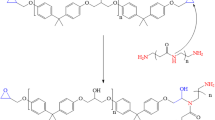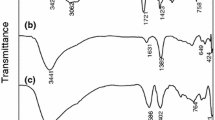Abstract
The addition of zinc phosphate pigment to standard epoxy coatings has been investigated as an anticorrosive and eco-friendly additive. In this study, we prepared two epoxy coatings without and with zinc phosphate for corrosion protection of AA7075-T6 substrates for different time exposures in NaCl solution. The two epoxy coatings were evaluated by electrochemical impedance spectroscopy and their surfaces were characterized by scanning electron microscopy. The results show that the addition of zinc phosphate to the anticorrosive formulation (epoxy resin–polyaminoamide) facilitated the formation of a barrier film, enhanced the barrier anticorrosive properties of the coatings and therefore inhibited the penetration of aggressive corrosive ions to the AA7075-T6 surface.








Similar content being viewed by others
References
Li Y, Zhang P, Bai P, Wu L, Liu B, Zhao Z (2018) Microstructure and properties of Ti/TiBCN coating on 7075 aluminum alloy by laser cladding. Surf Coat Technol 334:142–149
Sabouri M, Khoei SM (2018) Plasma electrolytic oxidation in the presence of multiwall carbon nanotubes on aluminum substrate: morphological and corrosion studies. Surf Coat Technol 334:543–555
Aryanto D, Sudiro T (2018) Preparation of ferrosilicon-aluminium coating using a mechanical alloying technique: study of thermal annealing on their structural characteristics. Surf Coat Technol 337:35–43
Dagdag O, Hamed O, Erramli H, El Harfi A (2018) Anticorrosive performance approach combining an epoxy polyaminoamide–zinc phosphate coatings applied on sulfo-tartaric anodized aluminum alloy 5086. J Bio Tribo Corros. https://doi.org/10.1007/s40735-018-0168-6
Dagdag O, El Harfi A, El Gana L, Hlimi Z, Erramli H, Hamed O, Jodeh S (2019) The role of zinc phosphate pigment in the anticorrosion properties of bisphenol A diglycidyl ether-polyaminoamide coating for aluminum alloy AA2024-T3. J Bio Tribo Corros. https://doi.org/10.1007/s40735-018-0200-x
Harscoet E, Froelich D (2008) Use of LCA to evaluate the environmental benefits of substituting chromic acid anodizing (CAA). J Clean Prod 16(12):1294–1305
García-Rubio M, De Lara MP, Ocón P, Diekhoff S, Beneke M, Lavía A, García I (2009) Effect of postreatment on the corrosion behaviour of tartaric–sulphuric anodic films. Electrochim Acta 54(21):4789–4800
Sulka GD, Parkoła KG (2007) Temperature influence on well-ordered nanopore structures grown by anodization of aluminium in sulphuric acid. Electrochim Acta 52(5):1880–1888
Kuznetsov B, Serdechnova M, Tedim J, Starykevich M, Kallip S, Oliveira MP et al (2016) Sealing of tartaric sulfuric (TSA) anodized AA2024 with nanostructured LDH layers. RSC Adv 6(17):13942–13952
Renaud A, Poorteman M, Escobar J, Dumas L, Bonnaud L, Dubois P, Olivier MG (2017) A new corrosion protection approach for aeronautical applications combining a Phenol-paraPhenyleneDiAmine benzoxazine resin applied on sulfo-tartaric anodized aluminum. Prog Org Coat 112:278–287
Niroumandrad S, Rostami M, Ramezanzadeh B (2016) Effects of combined surface treatments of aluminium nanoparticle on its corrosion resistance before and after inclusion into an epoxy coating. Prog Org Coat 101:486–501
Hu T, Shi H, Fan S, Liu F, Han EH (2017) Cerium tartrate as a pigment in epoxy coatings for corrosion protection of AA 2024-T3. Prog Org Coat 105:123–131
Prosek T, Thierry D (2004) A model for the release of chromate from organic coatings. Prog Org Coat 49(3):209–217
Zhang W, Buchheit RG (2003) Effect of ambient aging on inhibition of oxygen reduction by chromate conversion coatings. Corrosion 59(4):356–362
Dagdag O, El Harfi A, Essamri A, El Bachiri A, Hajjaji N, Erramli H et al (2018) Anticorrosive performance of new epoxy-amine coatings based on zinc phosphate tetrahydrate as a nontoxic pigment for carbon steel in NaCl medium. Arab J Sci Eng. https://doi.org/10.1007/s13369-018-3160-z
Dagdag O, El Harfi A, Essamri A, El Gouri M, Chraibi S, Assouag M et al (2018) Phosphorous-based epoxy resin composition as an effective anticorrosive coating for steel. Int J Ind Chem 9(3):231–240
Blustein G, Deyá MC, Romagnoli R, Del Amo B (2005) Three generations of inorganic phosphates in solvent and water-borne paints: a synergism case. Appl Surf Sci 252(5):1386–1397
Snihirova D, Lamaka SV, Montemor MF (2012) “SMART” protective ability of water based epoxy coatings loaded with CaCO3 microbeads impregnated with corrosion inhibitors applied on AA2024 substrates. Electrochim Acta 83:439–447
Echeverría M, Abreu CM, Echeverría CA (2014) Assessing pretreatment effect on the protective properties of different coating systems against marine corrosion. Corrosion 70(12):1203–1218
Mahmoodi A, Ebrahimi M (2018) Role of a hybrid dye-clay nano-pigment (DCNP) on corrosion resistance of epoxy coatings. Prog Org Coat 114:223–232
Ding J, ur Rahman O, Peng W, Dou H, Yu H (2018) A novel hydroxyl epoxy phosphate monomer enhancing the anticorrosive performance of waterborne graphene/epoxy coatings. Appl Surf Sci 427:981–991
Deflorian F, Rossi S, Fedel M, Motte C (2010) Electrochemical investigation of high-performance silane sol–gel films containing clay nanoparticles. Prog Org Coat 69(2):158–166
Montemor MF, Snihirova DV, Taryba MG, Lamaka SV, Kartsonakis IA, Balaskas AC et al (2012) Evaluation of self-healing ability in protective coatings modified with combinations of layered double hydroxides and cerium molibdate nanocontainers filled with corrosion inhibitors. Electrochim Acta 60:31–40
Ammar S, Ramesh K, Vengadaesvaran B, Ramesh S, Arof AK (2016) Amelioration of anticorrosion and hydrophobic properties of epoxy/PDMS composite coatings containing nano ZnO particles. Prog Org Coat 92:54–65
Yu D, Wen S, Yang J, Wang J, Chen Y, Luo J, Wu Y (2017) RGO modified ZnAl-LDH as epoxy nanostructure filler: a novel synthetic approach to anticorrosive waterborne coating. Surf Coat Technol 326:207–215
Konios D, Stylianakis MM, Stratakis E, Kymakis E (2014) Dispersion behaviour of graphene oxide and reduced graphene oxide. J Colloid Interface Sci 430:108–112
Wu LK, Zhang JT, Hu JM, Zhang JQ (2012) Improved corrosion performance of electrophoretic coatings by silane addition. Corros Sci 56:58–66
Ghasemi-Kahrizsangi A, Shariatpanahi H, Neshati J, Akbarinezhad E (2015) Corrosion behavior of modified nano carbon black/epoxy coating in accelerated conditions. Appl Surf Sci 331:115–126
Mousavifard SM, Nouri PM, Attar MM, Ramezanzadeh B (2013) The effects of zinc aluminum phosphate (ZPA) and zinc aluminum polyphosphate (ZAPP) mixtures on corrosion inhibition performance of epoxy/polyamide coating. J Ind Eng Chem 19(3):1031–1039
Jalili M, Rostami M, Ramezanzadeh B (2015) An investigation of the electrochemical action of the epoxy zinc-rich coatings containing surface modified aluminum nanoparticle. Appl Surf Sci 328:95–108
Acknowledgements
We would like to thank the laboratory of metallurgical analysis, Cetim Maroc Développement (Centre Technique des Industries de la Mécanique) and quality control laboratory, Casablanca Aeronautics Group Figeac Aero. Aeronautical Technopole of Nouaceur, Mohammed V-Casablanca Airport, Morocco.
Author information
Authors and Affiliations
Corresponding authors
Ethics declarations
Conflict of interest
There are no conflicts to declare.
Rights and permissions
About this article
Cite this article
Dagdag, O., El Gana, L., Hamed, O. et al. Anticorrosive Formulation Based of the Epoxy Resin–Polyaminoamide Containing Zinc Phosphate Inhibitive Pigment Applied on Sulfo-Tartaric Anodized AA 7075-T6 in NaCl Medium. J Bio Tribo Corros 5, 25 (2019). https://doi.org/10.1007/s40735-019-0218-8
Received:
Revised:
Accepted:
Published:
DOI: https://doi.org/10.1007/s40735-019-0218-8




